
In 2021, the EU set up the NextGenerationEU (NGEU) fund ‚Äì worth around ‚Ǩ800¬Ýbillion ‚Äì to prop up the economies of its member states during and following the COVID-19 pandemic. While the money has been flowing to member states, the flow is slow and set to end in 2026. There is also a catch ‚Äì it is not ‚Äúfree money‚Äù, as it will have to be repaid in full between 2028 and 2058. Will repayment simply be passed down to the next generation of taxpayers, as the fund‚Äôs name aptly suggests? Halfway through the short life of this special fund, auditors point to several challenges, which does not bode well for the future.
The Recovery and Resilience Facility (RRF) represents the lion‚Äôs share of this novel instrument, with over ‚Ǩ700¬Ýbillion in grants and loans to member states. Spain and Italy stand to benefit the most from it. However, as of late March¬Ý2024, only just over a third of the funds available for disbursement under the facility have been paid out. In Spain and Italy, absorption of the traditional cohesion funds is lagging significantly behind the EU average too and, given that RRF funding ‚Äúcompetes‚Äù with cohesion funding, the picture is less than encouraging.
Three EU countries have not yet received any RRF funding ‚Äì the Netherlands, Ireland and Sweden. With most of the recovery fund yet to be disbursed but only about 2¬Ýyears left of the instrument, there is a pressing need for action. However, past experience shows that spending the money as quickly as possible does not bode well for the quality of the programmes. In fact, as deadlines approach, pressure to spend can quickly lead to more spending mistakes. Furthermore, spending on projects has yet to materialise in many EU¬Ýcountries. Unlike regular EU budget spending, where the Commission exercises greater control and oversight, RRF funds are subject to less scrutiny and more self-policing. This increases the risk of irregularities and even fraud.
To finance this unprecedented EU fund, the Commission has, for the first time in history, borrowed on the financial markets on an unprecedented scale. However, this type of borrowing ‚Äì once almost cost-free ‚Äì has given way to soaring interest rates in recent years. As we pass the halfway mark of the instrument‚Äôs short lifespan, there is increasing concern about the repayment of the loans taken from the financial markets for RRF funding, further fuelled by the absence of a dedicated source of EU funding to pay back the loans. With capital repayments set to begin in 2028, the timeline for addressing this financial obligation is approaching rapidly. Moreover, the budget is already feeling the strain of interest charges, which could rise to as much as ‚Ǩ27¬Ýbillion for the EU‚Äôs entire multi-year budgeting period, doubling initial estimates.
We should note that EU countries are individually responsible for repaying their RRF loans. Moreover, a portion of the loans on offer, amounting to ‚Ǩ90¬Ýbillion, will go unused, suggesting little interest in such financing. On the other hand, the borrowing used to fund grants paid out to EU countries ‚Äì along with the accompanying interest charges ‚Äì must be repaid collectively by the EU. However, there appears to be little enthusiasm among member states for increasing their contributions to the common pot.
But the clock is ticking and the need for a dedicated source of EU funding is becoming ever so pressing. EU¬Ýlawmakers will have to address this issue when discussing future budgets of the EU and consider whether the facility should be extended, whether the RRF can offer valuable lessons, or whether it could serve as a blueprint for future funding mechanisms.
“Halfway through the lifespan of the EU’s recovery fund, one should be careful about drawing conclusions on its achievements, as it is still too early to meaningfully assess its performance,” said ECA President Tony Murphy. Our auditors have already taken a deep dive into the various aspects of the recovery fund, and NGEU will remain a focal point of our work in the years to come. Since its launch in 2021, the ECA has assessed the compliance of EU recovery funding each year, in our annual report on the implementation of the EU budget (our findings regarding 2023 will be available in early October). In addition, we have assessed certain performance aspects of the NGEU/RRF, including how the Commission has assessed the national recovery plans, whether the overall performance of the facility can be measured at all, how the EU goes about managing its debt related to these funds, and how it carries out control checks.
In 2024 and 2025, we will be reporting on several other RRF-related issues. These will include business and labour-market reform, absorption, digital transformation, and the green transition.